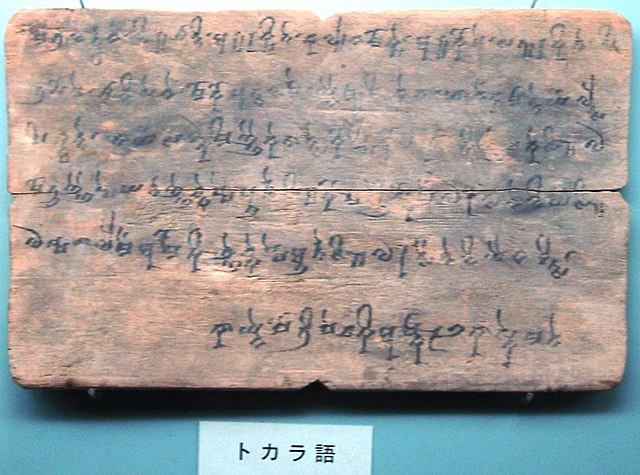热门问题
时间线
聊天
视角
吐火羅語
已滅絕語言 来自维基百科,自由的百科全书
Remove ads
吐火羅語(英語:Tocharian languages)是印歐語系最東方的一族顎音類語言,現已滅亡。

Remove ads
分類
吐火羅語族包含兩種語言,
歷史


- 1907年德國學者弗里德里希·威廉·卡爾·米勒在普魯士科學院學報發表論文,米勒根據一篇回紇文佛經跋文中一段文字:「回紇文的《彌勒下生經》,先從印度語譯為twγry語,又從twγry語譯為突厥語」,認為twγry就是歷史上的「Tokharoi」,因此將此種未為人知的語言定名為吐火羅語[3]。
- 德國哥廷根大學印度學教授埃米爾·西格和威廉·西格林教授研究格倫威德爾和馮·勒柯克從中國新疆吐魯番帶回柏林的婆羅米字母書寫殘卷,在1908年發表論文:《吐火羅語,月氏人之語言》[4]。作者認為吐火羅語,實為兩種方言,定名為甲種吐火羅語、乙種吐火羅語,又因為吐火羅語中的一些詞如 trai (三), oḵdh(八),mācaṟ(母親)等和印歐語中同意詞相似,定為吐火羅語為印歐語系。由於僅有甲種方言木簡中存在回紇文佛經跋文中提及的《彌勒下生經》殘卷,他們認為只有甲種方言才是twγry語,即吐火羅語。兩位學者還首次提出吐火羅語就是月氏語。
Remove ads
法國語言學家西爾萬·萊維研究1907年伯希和從新疆庫車和敦煌帶回巴黎的婆羅米文木簡,在1913年發表論文《所謂乙種吐火羅語即龜咨語考》[5],斷定庫車的婆羅米木簡屬於乙種吐火羅語;由於乙種吐火羅語不僅用於庫車佛寺而且用於官方通行證,萊維將「乙種吐火羅語」定名為龜茲語。萊維根據婆羅米木簡有「大王Swarnate」字句,考訂為《唐書》中於唐貞觀四年來朝的龜茲王白蘇伐疊,由此斷定龜茲語木簡的年代是唐貞觀年間。萊維又根據中國最早的2世紀佛經譯本中的佛教用語如「沙門」、「沙彌」不能對上梵文的sramana、sramenera,但與龜茲語的ṣamāne、ṣanmir很近,斷定中國2世紀佛經必定是從原始的龜茲語翻譯而來。
萊維將乙種吐火羅語考訂為龜茲語根據有三:
- 乙種吐火羅語婆羅米木簡出土自庫車;
- 乙種吐火羅語用於庫車佛寺和用於庫車官方通行證;
- 乙種吐火羅語婆羅米木簡有人名「Swarnate」,可考為龜茲王白蘇伐疊。
萊維考證乙種吐火羅語為龜茲語,論據充份,已為學界普遍接受為定論。
Remove ads
- 伯希和認為所謂「甲種吐火羅語」和「乙種吐火羅語」都不是吐火羅的語言,因為「Tokharoi 吐火羅」有濁送氣聲,不論「甲種吐火羅語」或「乙種吐火羅語」,都不存在這類濁送氣聲;他主張廢除「吐火羅語」這個稱呼,主張用甲種方言殘簡出土地之一的哈喇沙爾為名,改稱「甲種吐火羅語」為「哈喇沙爾語」(Qarasahr其實就是焉耆的維吾爾文稱呼)。
- 甲種吐火羅語殘卷中有「ārśi」一字。英國學者哈羅德·沃爾特·貝利認為ārśi就是玄奘《大唐西域記》中的阿耆尼(梵語Agni):「出高昌近地,自近者始,曰阿耆尼國。舊曰焉耆」;貝列最早稱甲種吐火羅語為焉耆語;此說已為大多數學者認同。他不贊成「哈喇沙爾語」(karacharien)這稱呼,因為「哈喇沙爾」雖然和焉耆是同地異名,但畢竟是維吾爾語,歷史上比較晚,不如焉耆恰當[6][7]。
英國學者瓦爾特·布魯諾·亨寧也認為「twγry"語言不是吐火羅語,聯繫「Tokharoi」是錯誤的,twγry應當是「吐何里tukri」(吐何里指高昌、焉耆一帶),他又認為吐何里人的先祖是古提人(Guti),即漢語文獻中的「月氏」[8][9]。
20世紀30年代,托馬斯·伯羅在討論3世紀的樓蘭和尼雅文獻時,首次提出了第三種吐火羅語。這些文獻以犍陀羅語寫成,但包含明顯源自吐火羅語的借詞,例如kilme(「地區」)、ṣoṣthaṃga(「稅吏」)和ṣilpoga(「文件」)。這種假設的語言後來被普遍稱為吐火羅語 C;有時也被稱為 Kroränian 或 Krorainic。[10]
吐火羅語學者克勞斯·T·施密特 (Klaus T. Schmidt) 在其2018年死後發表的論文中,介紹了10篇用佉盧文書寫的文本的譯文。施密特聲稱這些文本是用第三種吐火羅語寫成的,他稱之為Lolanisch。[11][12] He also suggested that the language was closer to Tocharian B than to Tocharian A.[12]他還認為這種語言更接近吐火羅語 B,而不是吐火羅語 A。2019年,由喬治·皮諾 (Georges Pinault) 和麥可·佩羅 (Michaël Peyrot)領導的語言學家小組在萊頓召開會議,將施密特的翻譯與原文進行比較。他們得出結論,施密特的譯文從根本上存在缺陷,沒有理由將這些文本與 樓蘭聯繫起來,他們記錄的語言既不是吐火羅語也不是普拉克里特諸語言,而是一種塞語。[13]
Remove ads
吐火羅語大約在公元840年左右滅亡,因為當時回鶻人被黠嘎斯人逐岀蒙古高原,遷移到塔里木盆地,並征服當地的吐火羅人。後世發現的從吐火羅語譯成回鶻文的文獻,為這條理論提供了依據。在回鶻人統治下,吐火羅人被外來的突厥語系——回鶻人所同化,其後代就是今日新疆維吾爾族居民的一部份。
特徵
吐火羅語殘卷內容,包括佛教和摩尼教的宗教文獻,寺院通信、帳目、商業文件、商隊通行證、醫學及巫術文件和一首情詩等。多數甲種吐火羅語、乙種吐火羅語的殘卷都是從梵文翻譯過來的,有的中間還穿插對佛陀的梵文頌詞或古代突厥語附註,從而提供解讀吐火羅語的鑰匙。西格和西格林經過多年努力,終於解通吐火羅語,著成《吐火羅語文法》一書。
吐火羅語的特徵是沒有送氣聲。名詞變化很多,譬如:單數的正格、主格、客格、屬格;複數的正格、主格、無特別的客格、有特別的客格、屬格;雙數正格;諸數的副格。
吐火羅語和印歐語的關係
1984年美國學者道格拉斯·亞當斯發表《吐火羅語與其他印歐語的關係》[18],用統計學方法推斷吐火羅語最接近日耳曼語,其次為希臘語、印度語、斯拉夫語、拉丁語。哈羅德·貝列認為月氏-吐火羅人說伊朗語,認為焉耆龜茲語是偽吐火羅語[19]。近期的詞彙統計學研究則認爲安那托利亞語族下屬語言可能與吐火羅語親屬關係最近[20][21]。
問題與爭議
參閱
註釋
參考文獻
外部連結
Wikiwand - on
Seamless Wikipedia browsing. On steroids.
Remove ads

